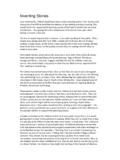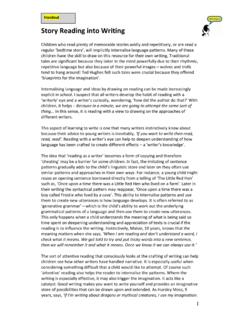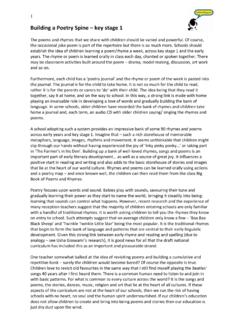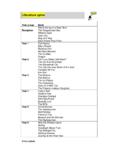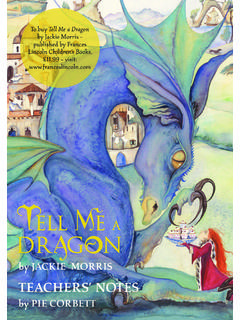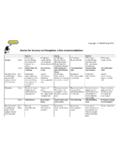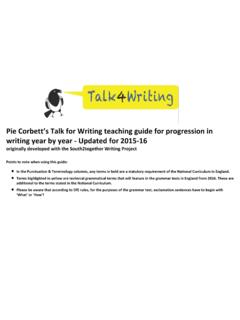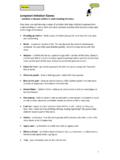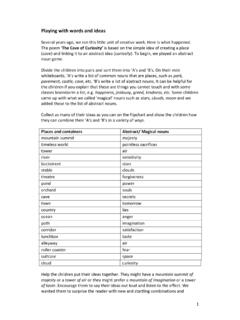Transcription of Independent writing - talk4writing.co.uk
1 1 Independent writing The aim of Talk for writing is to grow Independent writers. Here are some suggestions for how this can be achieved first in relation to narrative and then non-fiction. I then look at how such independence can be prepared for through the innovation stage of the imitation, innovation, Independent application process. Independent narrative writing As the children build up experience of writing stories, there should also be opportunities to write freely, drawing on everything that they have been taught. At the end of units, many schools have developed short really Independent units where the teacher provides a motivating starting point and the children write whatever they wish.
2 Children never become Independent readers until they choose what to read, developing their own taste for different authors and styles; in the same way, children are not writers until they make their own choices about what to write. Here are a few examples of KS2 units that provide time for children to write entirely independently drawing on the taught units. Start from a great stimulus and then list the possibilities with the class. They can then choose what to write. Provide a number of days for them to plan, draft, edit and publish their own writing : Example 1: Stranded the children have been shipwrecked on a desert island.
3 The children could: draw maps of the island; write diary entries and stories about the storm, logging the first few days of survival and even the rescue; find images of desert islands and write an advert for an island holiday; Invent their own island draw the map and write a leaflet about its flora and fauna; Write a monologue revealing the stranded sailor s wishes and dreams, hopes and fears; Write the sea captain s log depicting the rescue; Imagine that the ship s cat is also rescued; write a recount in the role of the cat! Write an alphabet of things found on the island, etc. Example 2: The Lighthouse use the short film The Lighthouse from the Literacy Shed.
4 The children could: write the story of what happened from the viewpoint of the lighthouse keeper/ the ship s captain/ a cabin boy or one of the villagers; 2 the event could be written up as a newspaper article or the keeper s log; write a poem about the storm ; write explanations of other ideas for saving the ship; write a list with ten ways to stop a lighthouse keeper from being bored ; find out about lighthouses and write a fact file; design the perfect lighthouse.; write the story that explains why the keeper is alone in the lighthouse, etc. Example 3: Voices in the Park respond to this great picture book (or any other decent picture book or novel).
5 The children could: write diary entries in role as different characters; write a short play based on the characters chatting at a bus stop; write letters between the two children; write about what happened from a park keeper s viewpoint; write a letter from the father persuading the mother to let the children play together and then write the reply; create the newspaper that the man is reading; write a letter that the mother has in her handbag; write about what you think will happen to the four main characters; write about the adults from the dog s view! write a transformation list poem in which park objects turn into other things, In the park, the roundabout becomes / a Catherine wheel sending out golden sparks.
6 In the park, a tree becomes / a flame shimmering in the autumn air. Example 3: The Adventures of Harris Burdick this wonderful book consists of a sequence of unrelated and rather disturbing images. Children choose one to use as a basis for writing . For example: If the chosen image is the front cover, what would the story title be? Write the story; Put 2 images together and link them; Write the story about Harris Burdick, explaining why he never returned! Take an image and write just the paragraph that goes with it. Then write the paragraph before and what happened next so that you have a mini story of 3 paragraphs.
7 Independent non-fiction writing Once a unit of work has been taught on any type of non-fiction, what has been learned should be applied independently across the curriculum. For example: Explain how a dragon s fire breathing equipment works; then use the transferable language patterns to explain the role of the skeleton and muscles for support, protection and movement; Once, the children have persuaded Bilbo to go on a journey with the dwarves, write a persuasive article about the role of diet, exercise and lifestyle in relation to healthy living. 3 In these examples, the main focus will be the children using what they have learned in science but revisiting their English work and writing independently.
8 Short-burst writing Some schools hold regular short-burst writing sessions. These may involve shared writing but on some occasions, the children will select their own image or use a starting point such as an object and write independently, taking the writing in their own direction. Photographs and works of art may act as intriguing stimuli. Try using unusual objects such as a brass lamp, a lit candle, a ship in a bottle, a rusty bicycle or a mirror. The trick is, perhaps, to make sure that you have used shared writing on many occasions so that the children know how to look carefully at the detail and use that to write a brief paragraph and bring the object alive through sharp description.
9 It is also worth helping them think through the possibilities . For instance, who is looking into the mirror and what are they thinking? Write a paragraph from the point of view of the sailor trapped, frozen to the spot inside the bottle. Where is the candle burning and who is there what are they doing, thinking or waiting for? Who is holding the brass lamp; where are they going? Put a character onto the bike as they are being chased! Challenging innovation as the route to independence Sometimes, you reach the end of a unit and the children have moved away considerably from the original model. It is worth remembering that young children, those who have just arrived in the country and those who struggle will need to hug closely to the original model.
10 This helps them to internalise the sentence and text structures so that they begin to acquire these as part of their linguistic repertoire. However, many confident young writers should not be hugging closely. At Watermoor Primary, the children decide whether they need to hug closely or shake hands with a model text. Shaking hands means deciding to use just the core transferable features and underlying plot idea. In this way, some children will be writing more independently within a unit. If we look at the extended model story Thog , it begins in this way: It had been a long climb up the mountain and, at last, Thog had reached the summit.
